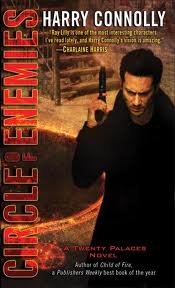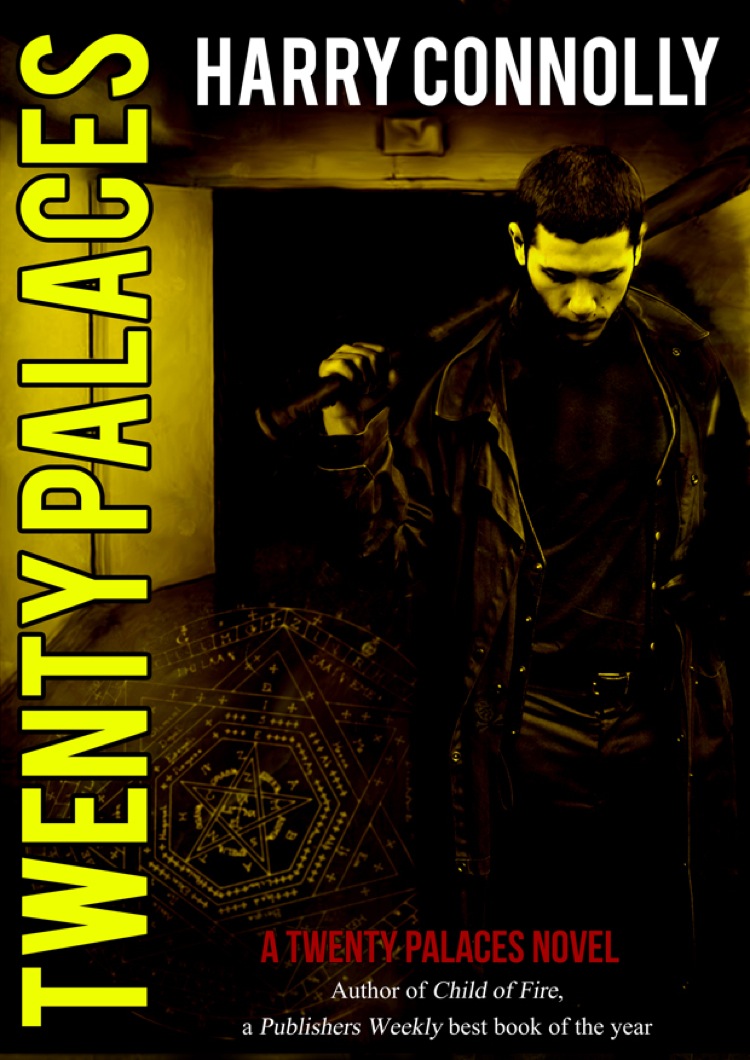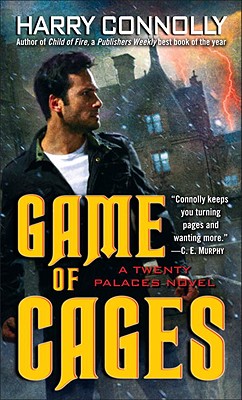Sean T. M. Stiennon reviews Circle of Enemies
Circle of Enemies
By Harry Connolly
Del Rey (320 pages, mass market first edition August 2011, $7.99)
And so we come full circle. Circle of Enemies is the final novel in the Twenty Palaces series as it stands, and in some ways the most crowded with monsters, sorcery, and mysteries. If it has one major flaw, it’s that it whet my appetite for a sequel that will likely never be written.
The action moves south from the Pacific northwest hamlets of Child of Fire (my review here) and Game of Cages (review) to the sun-scorched sidewalks and shadowy mansions of Los Angeles, as Ray revisits the life he lived before his stay in prison. One of his old friends from his carjacker days — a woman named Caramella — arrives in Ray’s Seattle room with a cryptic message: “You killed me, Ray.” After delivering it, she vanishes into thin air.
Magic — and all the horrors that accompany it — have found Ray’s old crew. He drives south to his old stomping grounds in Los Angeles to find his old allies and save them before the Twenty Palaces society arrives to wipe them out. The world is once again in danger from a predator with the potential to annihilate all human life, one hapless victim at a time.
Circle of Enemies is sweetened by substantial character development on Ray’s part. The closing chapters of Game of Cages saw him forced to commit horrifying acts against a horde of ordinary men and women driven mad by a predator’s influence, and the guilt he carries makes him more reluctant than ever to accept the Twenty Palace’s scorched earth tactics. He’s come a long way since his carjacking career, too — he has nostalgia and affection for his old crew and doesn’t want to see them become victims, but has become a man with no desire to rejoin them.
This book also has the strongest human villain of the series: Wally King, a porky fellow perpetually clad in jogging suits, one of Ray’s classmates from elementary school. He’s the picture of jolly innocence on the outside, but inside he’s so infested with predators that he’s barely human. His combination of blithe merriment and horrifying disregard for human life make every scene with him chilling reading.
Our understanding of the workings of magic, and the internal functioning of the Twenty Palaces society, also deepens in this book. Suffice to say that Connolly’s portrayal of the magical world begins the transition from a brief sketch to a complete picture, and it’s an enormous shame he won’t be continuing the series to build on the information revealed here.
 Annalise’s character is still inconsistent. When she eventually arrives on the scene, she’s become downright friendly with Ray. Part of that can be attributed to appreciation for Ray’s numerous victories, but it’s an unprecedented leap from Child of Fire, where she started out wanting to see him dead. It’s a necessary growth in their relationship for dramatic reasons, but I still don’t feel that it’s supported by the actual events of the books.
Annalise’s character is still inconsistent. When she eventually arrives on the scene, she’s become downright friendly with Ray. Part of that can be attributed to appreciation for Ray’s numerous victories, but it’s an unprecedented leap from Child of Fire, where she started out wanting to see him dead. It’s a necessary growth in their relationship for dramatic reasons, but I still don’t feel that it’s supported by the actual events of the books.
So, in summation, Circle of Enemies is awesome, and although I hate to see the series cut off prematurely, I can imagine worse conclusions. Now that we’ve arrived at the end, I’d like to take some time to look at the strengths and weaknesses of the four Twenty Palaces books taken together.
Strengths are easy to pick out. Each book had me by the throat from page one. My reading stamina is actually fairly low, so this is rare praise for me, but I found the Twenty Palaces novels quite literally hard to put down. Connolly has the elements of writing a page-turning thriller mastered, and his fantastic imagination is just the filling in the Twinkie.
As much as I’ve praised them before, I can’t say enough about the inventiveness and downright scariness of Connolly’s monsters. From the apocalyptic Wheel of Fire to the chilling Claws in Darkness, the predators of the Empty Spaces are never dull, and each one to creep onto the pages is a terrifying joy.
His choice of settings and set pieces is also fantastic. The small towns of Hammer Bay and Washaway (Child of Fire and Game of Cages, respectively) come across as living, pulsing communities, on a scale quite different from Harry Dresden’s Chicago or the New York of a thousand private eyes. Sequences like Child of Fire’s nail-biting conclusion in a network of caves under the Pacific Ocean and an encounter with several Claws in Darkness on an isolated northsea island are as good as any you’re likely to find in the wide world of action fantasy.
 In reading other reviews, the most common complaint I see about these books is that they don’t offer enough information about the Twenty Palaces society or the functioning of magic in Ray’s world. To some degree, these complaints are justified — four books in, I don’t think it’s even been mentioned what, exactly, the name “Twenty Palaces” refers to, and it’s true that Child of Fire and Game of Cages, in particular, are stingy with background information. This reflects Ray’s own ignorance about the magical world. I didn’t find this to be a problem, however. I enjoyed the sense of mystery it brought and the added weight it gave to every piece of information Ray, and thus the reader, did eventually uncover.
In reading other reviews, the most common complaint I see about these books is that they don’t offer enough information about the Twenty Palaces society or the functioning of magic in Ray’s world. To some degree, these complaints are justified — four books in, I don’t think it’s even been mentioned what, exactly, the name “Twenty Palaces” refers to, and it’s true that Child of Fire and Game of Cages, in particular, are stingy with background information. This reflects Ray’s own ignorance about the magical world. I didn’t find this to be a problem, however. I enjoyed the sense of mystery it brought and the added weight it gave to every piece of information Ray, and thus the reader, did eventually uncover.
The only serious problem I found involves characters. Ray is a competent hero and narrator, and, minus the issues I’ve highlighted, Annalise is cool and memorable. But beyond that pair, Connolly never establishes any broader cast of characters. The changing settings and the high body count of each novel combine to shuffle bit players completely between books, and I don’t recall that the aunt and uncle Ray lives with ever come on-stage after a supporting role in Twenty Palaces.
Contrast that with Jim Butcher’s Dresden Files, in which even the lackluster first novel, Storm Front, introduces five supporting players who return again and again in future books. More recent Dresden novels, in fact, draw much of their appeal from the vast network of allies and enemies that Butcher has developed over the course of fourteen novels and a bushel of short stories. Even the solitary Sherlock Holmes had his Lestrade, Mrs. Hudson, and Mycroft.
By contrast, Wally King is the only character beyond Ray and Annalise to appear in more than one Twenty Palaces novel (he’s in both Twenty Palaces and Circle of Enemies). The lack of any real supporting cast in the Twenty Palaces books can make them feel a little desolate. Ray is a lonely man, but I don’t necessarily want to feel lonely along with him, and I felt the books would have benefited from a few more familiar faces from one to the next.
In summation: As thrillers bordering on horror, with absolutely spectacular monsters thrown into the blend, the Twenty Palaces novels are solid gold in spite of a few flaws, and I’m happy to say that I look forward to whatever stories emerge from Harry Connolly’s fingertips in the future.
Sean T. M. Stiennon is a writer, martial artist, and mecha pilot from Wisconsin. In his spare time, he meditates by the glow of his computer screen and does tai chi in public. He’s currently working on a novel set in a mythic version of medieval Japan. His previous reviews of Twenty Palaces novels include Twenty Palaces, Child of Fire, and Game of Cages
[…] Sean T M Stiennon Reviews Circle of Enemies […]